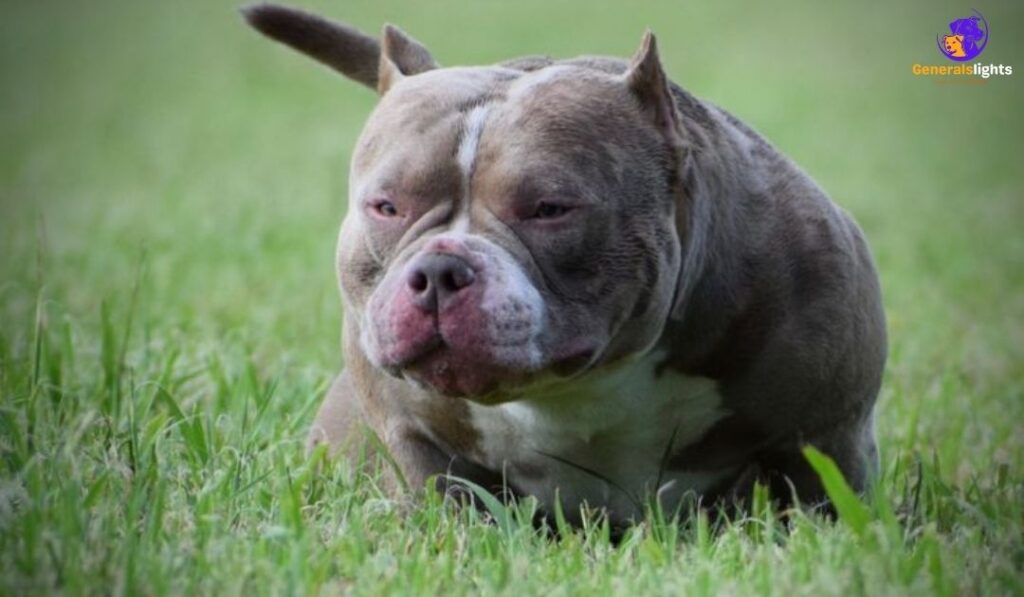A Tri-Color Blue Bully is a unique variation of the American Bully breed, showcasing three striking colors in its coat, blue, tan, and white. This rare color pattern adds to its charm and appeal.
Looking for an American Bully with a striking appearance? The Tri-Color Blue Bully is a head-turner with its rare and bold color mix. It’s not just about looks—this breed is known for its friendly, loyal nature too. If you’re after a companion that stands out, this beauty won’t disappoint.
The Tri-Color Blue Bully features a stunning blend of blue, white, and tan in its coat. These American Bullies have a muscular build, and their affectionate temperament makes them ideal family pets. With strong genetics, the Tri-Color Bully often gets attention for its unique and eye-catching look.
Overview of the Tri-Color Blue Bully
The Tri-Color Blue Bully is a rare and stunning variation of the American Bully breed. It displays a mix of blue, tan, and white, which sets it apart from other bullies. Known for their muscular build and confident stance, these dogs are not just visually impressive but also have great personalities. Their rarity and unique color pattern make them highly sought after.

In addition to their looks, Tri-Color Blue Bullies are known for their gentle and loyal temperament. They form strong bonds with their families and are great with kids. Despite their tough appearance, these bullies are friendly, loving, and social dogs. Their balanced nature makes them perfect companions for both experienced and new dog owners.
Appearance, Temperament, and Characteristic Traits
The Blue Bully stands out with its muscular frame and striking blue coat. Its broad chest, strong legs, and well-defined muscles give it a powerful appearance. The short, glossy coat of the American Bully adds to its sleek and eye-catching look. Despite its robust build, the Blue Bully carries itself with grace and confidence.
| Characteristic | Description |
| Coat Color | Blue, with occasional white markings |
| Build | Muscular, stocky, and athletic |
| Size | Medium to large, depending on the type |
| Temperament | Loyal, affectionate, and friendly |
| Exercise Needs | Moderate to high |
| Family Compatibility | Excellent with children and families |
| Lifespan | 10-12 years |
| Social Behavior | Friendly with other pets and strangers |
The Blue Bully is known for its loyal and protective nature. It thrives on human interaction and makes a great family pet. While they may look intimidating, these dogs are gentle and affectionate towards their owners. Their playful and friendly attitude makes them ideal companions for families with children.
Dietary Needs
The Blue Bully requires a balanced diet rich in protein to support its muscular build. High-quality kibble, lean meats, and supplements like omega-3 help maintain coat health and energy levels. Avoid feeding them processed foods or excessive treats to prevent obesity.
Feeding should be portion-controlled to match their size and activity level. Adult American Bullies typically need two meals a day to maintain optimal health. Puppies, on the other hand, benefit from smaller, more frequent meals as they grow.
Exercise Needs
The Blue Bully thrives with regular exercise to maintain its strong physique and mental well-being. A combination of daily walks and playtime will keep them happy and healthy. Activities like running or agility training are also great for their energy levels.
Without proper exercise, these dogs may become bored and develop destructive behaviors. American Bullies generally require moderate to high physical activity to stay fit, so regular outings are essential.
Training
Training a Blue Bully should start early with consistency and positive reinforcement. These dogs are intelligent and eager to please, which makes them quick learners. However, they need firm, patient guidance to avoid developing stubborn habits. Socialization is key to ensuring they remain friendly around strangers and other animals.
Grooming Needs
The Blue Bully has a short, smooth coat that’s easy to maintain. Weekly brushing helps remove loose hair and keeps their coat shiny. Regular ear cleaning, nail trimming, and dental care should also be part of their grooming routine. Though they are low-maintenance in terms of shedding, occasional baths are recommended to keep their skin healthy.
Health Concerns for the Tri-Color Blue Bully
Like other American Bullies, the Tri-Color Blue Bully may face several health concerns due to its genetic makeup. Common issues include hip dysplasia, a condition that affects joint mobility, and allergies, which can cause skin irritations. These dogs are also prone to obesity if their diet isn’t properly managed, so maintaining a balanced diet is key.

| Health Concern | Description |
| Hip Dysplasia | Abnormal joint development causing pain |
| Skin Allergies | Irritations from allergens or poor diet |
| Obesity | Overfeeding leads to weight gain |
| Heart Disease | Common in larger bully breeds |
| Bloat (Gastric Dilatation) | Sudden stomach twisting, life-threatening |
| Cherry Eye | Prolapse of the third eyelid |
| Ear Infections | This can occur due to their floppy ears |
| Joint Issues | Arthritis or other mobility problems |
In addition to these concerns, Tri-Color Blue Bullies can experience heart disease and bloat, especially in larger varieties. Regular vet checkups and a healthy lifestyle can reduce the risk of many issues. Early detection and care are vital for maintaining their long-term health and quality of life.
Hip Dysplasia
Hip dysplasia is a common concern for Tri-Color Blue Bullies, particularly because of their muscular build. This condition occurs when the hip joint doesn’t form correctly, leading to pain and mobility issues. Without proper treatment, it can result in arthritis as they age. To reduce the risk, regular exercise and maintaining a healthy weight are crucial. Early detection through vet checkups can also help manage symptoms and improve the dog’s quality of life.
Skin Allergies
The Tri-Color Blue Bully is prone to skin allergies, often triggered by food or environmental factors. These allergies can cause itching, redness, and hair loss. It’s important to feed them a high-quality, allergy-friendly diet and avoid harsh chemicals in grooming products. Regular vet visits can help identify and manage allergic reactions. Keeping their skin healthy with proper nutrition and care can reduce the likelihood of these issues.
Obesity
Due to their stocky build, Tri-Color Blue Bullies can easily gain weight if not fed properly. Obesity puts extra strain on their joints and increases the risk of heart disease. Owners should monitor portion sizes and avoid overfeeding. Regular exercise helps burn off excess calories and keeps them in shape. A well-balanced diet with controlled portions can prevent weight-related health concerns.
Heart Disease
Like many large breeds, the Tri-Color Blue Bully may be at risk for heart disease. This issue can develop over time, especially if they’re not getting the right amount of exercise or if their diet is poor. Symptoms can include lethargy, coughing, and breathing difficulties. Regular heart checkups at the vet and a healthy lifestyle are essential for preventing and managing this condition. Early diagnosis often leads to better treatment outcomes.
Bloat (Gastric Dilatation)
Bloat, or gastric dilatation-volvulus (GDV), is a life-threatening condition that can affect Tri-Color Blue Bullies. It occurs when the stomach fills with gas and twists, cutting off blood flow. Signs include a swollen belly, restlessness, and difficulty breathing. Immediate vet care is critical to saving the dog’s life. To help prevent bloat, avoid feeding them large meals in one sitting and ensure they don’t exercise right after eating.
Cherry Eye
Cherry eye is a condition where the third eyelid of the Tri-Color Blue Bully prolapses, creating a red, swollen appearance in the corner of the eye. It’s usually not painful but can cause irritation and lead to further eye problems if untreated. Surgery is often required to correct this issue. Regular eye checkups can help detect the condition early and prevent complications.
Joint Issues
Due to their muscular and compact structure, Tri-Color Blue Bullies are prone to joint issues, particularly as they age. Conditions like arthritis and elbow dysplasia can develop, causing discomfort and reduced mobility. Maintaining a healthy weight and providing joint supplements can help keep their joints strong. Regular vet assessments are key to monitoring their joint health and ensuring they stay active for longer.
Managing These Health Complications
Managing health issues in the Tri-Color Blue Bully requires a proactive approach, starting with regular vet checkups. Early detection of conditions like hip dysplasia or heart disease ensures timely intervention. Feeding them a balanced diet and maintaining a healthy weight also play a crucial role in preventing complications.

Exercise is equally important for keeping their joints and heart healthy. Owners should provide activities that match the dog’s energy level, while also monitoring for signs of discomfort or pain. Consistent care and attention can significantly improve the dog’s quality of life and longevity.
Regular Vet Checkups
Routine vet visits are essential for detecting early signs of health issues in Tri-Color Blue Bullies. Regular screenings can help identify problems like heart disease or bloat before they become severe. Your vet may also recommend dietary changes or supplements to support joint health. Keeping up with vaccinations and flea/tick treatments is another part of managing their overall well-being.
Balanced Diet
A balanced diet rich in proteins, healthy fats, and essential vitamins is crucial for preventing obesity and other health issues. High-quality dog food supports their muscular build and keeps their skin and coat healthy. Avoiding foods that trigger allergies is also important. Controlled portions and feeding schedules help maintain a healthy weight and prevent conditions like bloat.
Regular Exercise
Exercise is vital for managing joint issues and keeping the Tri-Color Blue Bully fit. Daily walks, play sessions, and activities like agility training help burn off excess energy and keep their muscles strong. Owners should avoid over-exercising puppies to protect their developing joints. Keeping them active helps prevent obesity and supports cardiovascular health.
Joint Health Maintenance
To manage joint issues like hip dysplasia, owners should focus on joint health from an early age. Providing joint supplements such as glucosamine and chondroitin can improve mobility and reduce discomfort.
Low-impact activities like swimming are great for exercise without putting too much pressure on their joints. Regular vet checkups can monitor any signs of arthritis or stiffness.
Preventing Bloat
Preventing bloat in the Tri-Color Blue Bully involves feeding them smaller, more frequent meals and ensuring they rest after eating. Avoid giving them large meals or letting them drink excessive water quickly. Using a slow-feed bowl can help prevent gulping, which reduces the risk of stomach twisting. Regular vet visits can also offer advice on how to minimize the risk of this dangerous condition.
Cost Considerations When Buying a Blue Bully
Purchasing a Blue Bully can be expensive, with prices ranging from $2,000 to $10,000 depending on the dog’s lineage and breeding quality. Factors such as the breeder’s reputation, the dog’s tri-color coat, and overall health will influence the final cost. Keep in mind that these initial costs don’t cover ongoing expenses like food, vet visits, and grooming.

| Expense Type | Cost Estimate |
| Initial Purchase Price | $2,000 – $10,000 |
| Vet Checkups | $200 – $500 per year |
| Vaccinations | $75 – $150 per year |
| Food (Annual) | $500 – $1,200 |
| Grooming | $50 – $100 per session |
| Training Classes | $100 – $300 for basic training |
| Pet Insurance | $300 – $600 per year |
| Joint Supplements | $100 – $200 per year |
Aside from the purchase price, you should budget for additional costs like pet insurance, which can help with future health issues. Training classes are also essential to ensure a well-behaved and socialized dog. Investing in quality food and joint supplements will help maintain your Blue Bully’s overall health and reduce potential vet bills down the road.
The Tri-Color Blue Bully: More Than Just a Colored American Bully
The Tri-Color Blue Bully is a stunning variation of the American Bully, celebrated not only for its unique coloration but also for its impressive personality. This breed boasts a muscular build and a gentle temperament, making it an excellent family companion. The vibrant mix of blue, tan, and white in its coat adds to its appeal, capturing the attention of dog lovers everywhere.
Beyond their striking appearance, Tri-Color Blue Bullies offer loyalty and affection that enrich the lives of their owners. Their friendly demeanor makes them great with children and other pets, creating a harmonious home environment. With the right training and socialization, these dogs can thrive as well-rounded companions, proving they are much more than just a pretty coat.
Unique Coloration
The unique coloration of the Tri-Color Blue Bully is one of its most appealing features. This breed showcases a beautiful combination of blue, tan, and white, setting it apart from other bullies.
The tri-color pattern is not just visually striking but also rare, making it highly sought after by breeders and enthusiasts. This distinctive appearance often draws attention, making them stand out in any crowd. Their vibrant coat is a testament to their unique genetic background.
Gentle Temperament
Despite their tough appearance, Tri-Color Blue Bullies are known for their gentle temperament. These dogs are friendly and affectionate, often forming strong bonds with their families. Their loyalty makes them excellent companions, as they thrive on human interaction and love being involved in family activities.
With proper training and socialization, they can adapt well to various environments, including homes with children. Their calm demeanor is one of the many reasons they make such beloved pets.
Health Considerations
Like all breeds, the Tri-Color Blue Bully has specific health considerations to keep in mind. They can be prone to conditions such as hip dysplasia, allergies, and heart disease. Regular vet checkups and a healthy lifestyle are crucial for preventing these issues and ensuring long-term well-being.
Providing a balanced diet and appropriate exercise will help maintain their overall health. Being proactive about their care can lead to a happy and healthy life.
Training Needs
Training is essential for the Tri-Color Blue Bully to ensure they develop good behavior and social skills. These dogs are intelligent and eager to please, which makes training relatively easy when approached positively. Consistent commands and rewards help reinforce desired behaviors, making training enjoyable for both the dog and the owner.
Early socialization is also critical to prevent any potential behavioral issues. Investing time in training will pay off with a well-mannered and confident companion.
Lifestyle Compatibility
The Tri-Color Blue Bully fits well into various lifestyles, from active families to individuals seeking companionship. They require regular exercise to stay healthy, but they also enjoy a relaxing time at home. Their adaptability makes them suitable for both apartments and houses, as long as their exercise needs are met.
These dogs thrive on companionship, making them perfect for those who can provide attention and love. Their versatility ensures they can be a wonderful addition to many households.
FAQs
What makes the Tri-Color Blue Bully unique?
The Tri-Color Blue Bully stands out due to its striking coat of blue, tan, and white. This unique coloration adds to its appeal among American Bully breeds.
Are Tri-Color Blue Bullies good with children?
Yes, Tri-Color Blue Bullies are known for their gentle temperament. They are affectionate and loyal, making them great companions for families with children.
What health issues should I be aware of?
Common health concerns for Tri-Color Blue Bullies include hip dysplasia, allergies, and heart disease. Regular vet checkups help monitor and manage these risks.
How much exercise do they need?
Tri-Color Blue Bullies require regular exercise to stay healthy and happy. Daily walks and playtime keep them fit and help prevent behavioral issues.
How can I train a Tri-Color Blue Bully?
Training a Tri-Color Blue Bully is essential for good behavior. Use positive reinforcement techniques, consistent commands, and early socialization to ensure success.
Conclusion
The Tri-Color Blue Bully is a beautiful and unique variant of the American Bully, known for its stunning coat and affectionate nature. This breed combines striking aesthetics with a gentle temperament, making it an ideal family companion. Their loyalty and love enrich the lives of those who welcome them into their homes.
In addition to their beauty, the Tri-Color Blue Bully requires proper care, training, and exercise to thrive. Being proactive about their health and well-being ensures a long, happy life together. By investing time and love, you can enjoy a rewarding relationship with this remarkable breed.
- >>>Also Read Must:
- Pure Harmony Dog Food: Honest Review
- Why Boxers are Considered the Worst Dogs | Dogisty
- What You Need to Know About the Tri-Colored Bully | A Guide

Emerson is an expert in the world of pets, specializing in understanding diverse breeds, nutrition, and health. His deep knowledge ensures your pets receive the best care, from balanced diets to top-notch health advice, keeping them at their happiest and healthiest.











